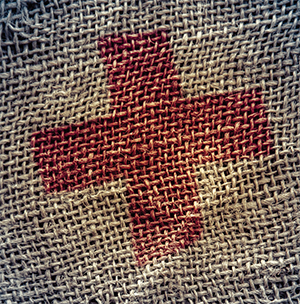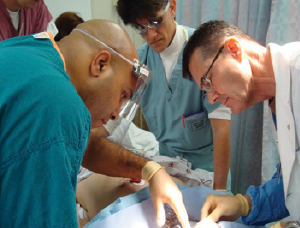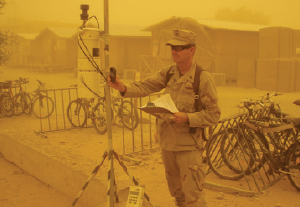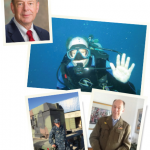
Mr Doomits/shutterstock.com
Richard Meehan, MD, can still hear the distinctive sound of footsteps that would travel along a gravel path toward his wooden hut in the middle of the night in Iraq.
“I’d hear somebody walk from the command post, either toward my hut or the operations officer who slept in the hut next to mine,” says Dr. Meehan, a rheumatologist and immunologist at the National Jewish Health Hospital (NJH) in Denver. “I hoped the footsteps would stop at his door, because that meant there was a logistic problem. If they stopped at my door, that meant someone was seriously injured.”
Dr. Meehan, age 67, is a retired Naval Reserve officer who served in two wars: the Gulf War—code named Operation Desert Storm—in 1991, and the Iraq War, or Second Persian Gulf War, in 2008. His memories of both wars are conflicted, filled with pride and pain, relief and sorrow. Still, he says nothing compares to his experiences in military medicine, remembering the lives he helped save and the brave service men and women who touched his soul.
Sense of Duty

Dr. Meehan, a Seabee Battalion Surgeon, conducts a community medical engagement near the Syrian border in 2008.
richard meehan, md (top & bottom);
Dr. Meehan signed up for the U.S. Navy Reserve in 1988 at age 39, joining a long list of family members with military service. He explains that the U.S. Navy generally does not recruit people who are 40 years of age or older unless they possess critically needed skills.
“It was an obligation,” he says, adding that his father and uncles had served during WWII. “I was healthy, able to do it, interested in military medicine and thought it would help me do a better job with my research at NASA involving environmental immunology.”
Dr. Meehan began working part time at the Johnson Space Center at NASA in Houston in 1984, where he also served as an assistant professor at the University of Texas at Galveston. For the next four years, he conducted immunology and physiology studies on astronauts, U.S. Air Force Academy cadets in prisoner of war training and U.S. Army soldiers in high-altitude training. He compared their blood samples before and after training or space missions and taught astronauts how to take their own retinal photos during their first few days of space flight.

During a Navy Trauma Training Course prior to deploying to Iraq, Dr. Meehan and a team of Navy Corpsman treated gang-related shooting victims at the USC emergency department.
Navy Corpsman Craig Meaders, HMC
“The effect of environmental stress, whether it’s prisoner of war or combat training, high altitude or space flight, affects the T cell function more than the B cell function,” he says. “It wasn’t unique to microgravity, probably just the stress of launch, re-entry or risk of something going wrong that affected the immune system.”
As it turned out, Dr. Meehan wasn’t deployed until the Gulf War in 1991, two years after leaving his job at NASA. Now divorced with two small children, he was working as a rheumatologist and immunologist at the University of Colorado in Denver.
He was among the 200 fleet hospital staff shipped to Bahrain, an island nation off the coast of Saudi Arabia. Often referred to as the Dirt Navy, the large tent hospital accommodated 500 beds and supported roughly 30 physicians who worked more than 12-hour shifts each day.
At the time, he says, everyone was very concerned about the welfare of warrior patients.
“We knew Saddam Hussein had used chemical weapons on the battlefield against civilians and in the war with Iran, so he was willing to use it on our forces,” Dr. Meehan says. “There’s very little defense if you use chemical weapons on the battlefield. You have to pack up and leave; you can’t stay and function.”
Evacuating soldiers and Marines for medical reasons wasn’t always easy. Despite the horrors of war, he says, no one wanted to leave, because they were very dedicated to each other.

Dr. Meehan conducted particulate sampling during a dust storm at the Al Asad Air Base in 2008, which led to the founding of the NJH Center of Excellence on Deployment-Related Lung Disease. Cecile Rose, an occupational medicine pulmonologist, and Dr. Meehan serve as the director and co-director, respectively. Their current research is investigating the role of inhalation exposures on small airway injury among military personnel who were deployed to Southwest Asia.
He tells the story of one soldier who was in intensive care due to severe asthma. Although he was going to be evacuated back home, he vehemently protested, recalls Dr. Meehan. The soldier was in charge of operating a battery of Patriot missiles, which destroyed SCUD missiles fired by Iraqi soldiers loyal to President Hussein that could be armed with chemical or biological agents.
“If he got evacuated, then the Patriot missiles wouldn’t knock out the SCUD missiles as effectively,” Dr. Meehan says, adding that to help save soldiers’ lives, he reversed his decision and ensured that the soldier’s medical officer had 24/7 access to hospital staff to help treat his asthma. “In military medicine, sometimes you make medical decisions that can impact a lot of people.”
Meanwhile, Dr. Meehan tried to keep his mind and body in shape. Every day, he ran for one hour around a loop inside the military compound with a gas mask at his side and read everything he could find about intensive care medicine, because he was assigned to the ICU.
Fortunately, he says, the hospital never reached capacity. Best of all, not one patient who was treated in his Fleet Hospital died.
Back to Civilian Life
Nearly three months after arriving in Bahrain, the war ended, and Dr. Meehan returned home to his family and job at the University of Colorado Medical Center. He served as an assistant professor and then an associate professor in the school’s rheumatology division and also received NASA and Department of Defense (DOD) grants to conduct immunology and rheumatology research similar to that he had performed in Houston.
Five years after the Gulf War, he was remarried to a woman named Jane, a widow with three children whom he had known from their church in Houston. Now supporting five children, Dr. Meehan found a more lucrative position at Kaiser Permanente as a rheumatologist and general internist. But he says the job wasn’t a good fit, and after three years, he joined the medical staff in 1999 at NJH as its only rheumatologist.
Many years went by as he continued his research, treated patients and built up the hospital’s rheumatology division, which now supports six rheumatologists.
‘The effect of environmental stress, whether it’s prisoner of war or combat training, high altitude or space flight, affects the T cell function more than the B cell function.’ —Dr. Meehan
In Harm’s Way
In September 2007, Dr. Meehan was deployed once more, this time to the Al Anbar Province in western Iraq. As the senior medical officer, his year-long assignment involved taking care of the medical needs of a battalion of 542 Seabees, the Navy’s Construction force assigned to the Marine Expeditionary Forces. Approximately 15 Navy corpsmen were assigned to him.
Before deployment, they were stationed at Port Hueneme Naval Construction Base in California for several months, receiving combat training. He also completed an intensive, 19-day Navy trauma medical course in the emergency department at the University of Southern California (USC) Medical Center that involved 18-hour workdays in the cadaver lab, lectures and treating patients who were victims of gang-related shootings.
“It was a very good experience for me,” he recalls. “I felt very confident that once I went to Iraq, I could do whatever was necessary to save the life of a critically injured Seabee. Nothing decreases stress more than being prepared.”
And there was plenty of stress. He says the Seabees traveled throughout western Iraq, building combat outposts. The biggest risk to his battalion was improvised explosive devices that terrorists had planted along the roads.
But urban warfare offered other dangers.
“In Iraq, you can’t tell the difference between the people who like you and the people who want to kill you,” he says, adding that while stationed at the Al Asad Air Base, he made numerous trips along dangerous roads to several combat posts, villages and various cities, including Fallujah and Ramadi.
In between treating soldiers for combat injuries and illnesses, he completed the Seabee Combat Warfare Officer and Fleet Marine Force Officer training programs to ensure he had the same combat training as other officers.
“I wanted to know everything about the weapons, what they did, in case something went wrong,” he says, adding that he routinely carried a 9 mm sidearm and an M16 rifle when traveling. “I had to also be able to use a machine gun in the turret if the gunner went down.”
Luckily, Dr. Meehan had to fire his weapons only during target practice. He was never involved in any direct, small arms fire.
When it came time for him to leave Iraq in 2008, he was relieved. No Seabees in his battalion had died.
Unlike his previous deployment in the Gulf War, where returning troops were back in the U.S. within 72 hours, Dr. Meehan and other Seabees were initially sent to Kuwait for one week, which wasn’t a combat zone. In this “warrior transition program,” he says, they surrendered their weapons and supported or comforted each other by talking among themselves about their experiences. Then they traveled back to Port Hueneme to de-stress for several weeks before returning home. He believes this down time was very therapeutic and reduced incidents of post-traumatic stress disorder.
More Work Ahead
Dr. Meehan never really stopped treating warriors. In 2009, he and Cecile Rose, MD, who practices occupational and pulmonary medicine, launched the nation’s first post-deployment lung health program at NJH. Supported through DOD grants and donors, it’s dedicated to service members and contractors who were deployed to Iraq and Afghanistan and returned with complex pulmonary problems associated with airborne hazards. So far, the program has treated 150 service men and women.
Looking back, perhaps the experience Dr. Meehan misses most from military medicine is the camaraderie he enjoyed among the soldiers, sailors, airmen and Marines with whom he deployed.
“It’s the ultimate team sport, deploying to a combat zone,” he says. “I hope other, younger doctors will consider military medicine. It was rewarding for me, and I learned a lot. It makes you a better consultant and physician.”
Carol Patton is a freelance writer based in Las Vegas.
Note: To refer service personnel to the NJH Center of Excellence on Deployment-Related Lung Disease, contact Dr. Meehan via email at [email protected].
Richard Meehan: The Early Years
- 1974: Graduated from the University of Texas Medical School at Houston
- 1977: Completed his internal medicine residency at the University of Iowa
- 1977–1980: Worked as a general internist at Salem Clinic, a large medical practice in Salem, Ore., where he also inherited a rheumatologist’s patients and developed an interest in rheumatology
- 1980–1984: Completed rheumatology and immunology fellowships at the University of Iowa
